

All Snake, all the time
Over the wails of frustration from the few residents of the Insider Nation complaining about the current “all-Snake-all-the-time” format … sorry ‘bout that, and here we go again.
Last Friday, I left the floor open for further comments/discussion about the fate of the original yellow Snake 'Cuda, and quite a few of you decided to stroll out for a little dance of your own, and, boy, can you guys tango.
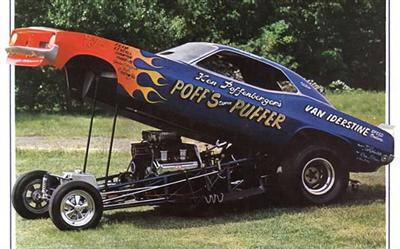 |
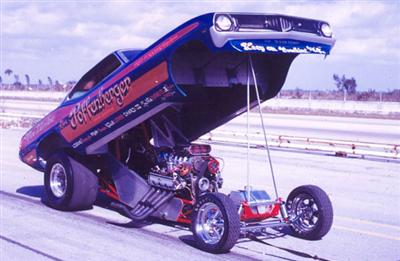 |
Dan Tuttle was among the first to weigh in. “Comparing photos 9 and 10, if you look closely at the location of the top framerail in comparison to the cylinder head, you can see an obvious difference. On the Scrima car, the top framerail is above the headers on the outside of the valve covers. In the next shot, a year later, the top framerail is tucked under the headers. The Scrima car also was a sprung-rear-end car with ladder bars, while it is hard to see it on the Logghe car. Looking at it from the chassis builder's perspective, in order to make those changes to the car, the top framerail would have been replaced naturally. Also, the entire chassis would have been cut in two down the middle and narrowed 6 to 8 inches to get the framerails inside the cylinder heads. With this big of a change, most chassis builders would recommend buying a new car, as the cost of updating to this extent would be about the same. I would say that those are not the same chassis.”
Among those weighing in was NHRA historian Greg Sharp: “Like you, I have a headache and won’t even begin to get into this one with people a lot more knowledgeable than me about early Funny Car history! I will however comment that [Bret] Kepner’s 'damned Prudhomme-initiated Keystone SS wheels on the front' were actually Cragars and a reflection of Prudhomme and McEwen’s long relationship with Cragar Industries, Bell Auto, and Roy Richter, one of the great innovators and true gentlemen in this industry.” I should have caught that as the Cragar decal was omnipresent on Prudhomme’s cars, and if you go back to the installment, you’ll see that I’ve fixed this in blogger-cool strikethrough fashion that leaves his original statement intact yet corrected. I’ve begun to realize that any single Insider column taken out of context of the whole column (which is probably how people will find it via search engine) might not have the final word after you all have weighed in. I wish I had done that from the outset of the column.
Lance Peltier observed, “Looking at the Mr. Natural pictures, I would disagree that is the original Snake body. When looking at the rear view of the wreck, the rear-window shape is totally different (it arches more in the bottom center), the B pillars meet the fenders differently, there is more top of fender on the yellow body, and the bottom of the roof on the yellow body has a molding strip molded in. Also, the side body lines that run down the sides of the car on the yellow car are more distinct, and the Mr. Natural has side marker lights, none on the yellow body.”
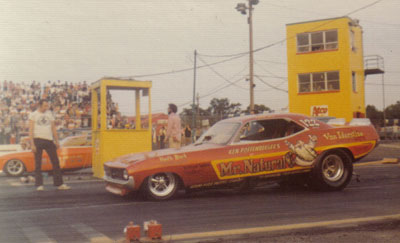 |
I heard from Tony Williams, who worked at Atco as the announcer and starter from 1972 to 1998 and sent the great photo at right (and several others), showing the Mr. Natural 'Cuda on the starting line for what Williams said is the beginning of the fateful April 1973 run at Atco in which Tom Hall scorched the body.
Some of you might have wondered why I didn’t try to contact Poffenberger or Miller directly to ask about the 'Cuda. It’s pretty common knowledge that Miller died in an oilfield accident some years ago, and I was pretty sure I had read that Poffenberger had passed away. Sure enough, I heard from Jerry Smith, who’ll soon be enjoying his own 60th anniversary, who follows the column regularly and grew up in New Jersey with an older brother, Keith, who ran a Funny Car at the time; they were friends with Sammy Miller and Ken Poffenberger. He confirmed that Poffenberger also passed away a few years ago and gave me contact info for Miller’s son, Sammy Jr., whom he thought might know something.

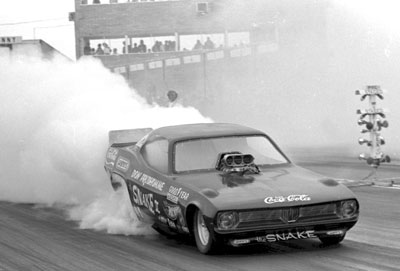 |
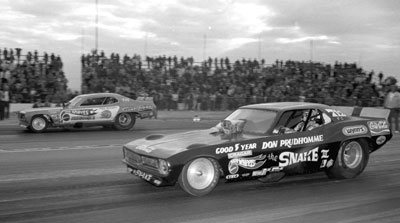 |
In my column about the Snake III 'Cuda, a few wrote to ask about my inclusion of Beeline Dragway in its history, as most people know only of its debut at the 1972 Supernationals and its runner-up to Tom McEwen at Lions Drag Strip’s Last Drag Race Dec. 2. To be truthful, I had to rewrite that portion of the column just before publishing after receiving the Steve Reyes photos at right of the car racing against McEwen’s Mongoose II Duster at the famed Arizona raceplant.
Regular Insider photo contributor Bob Snyder was among those tossing question marks my way; he had attended the AHRA Winternationals in January 1973 and insists that the car was not there and sent photos of “Snake” driving his yellow Hot Wheels Top Fueler as proof and says that Prudhomme’s name is not on the list of 32 qualified Funny Car drivers at the event. We’ve already established that Prudhomme did not run the car at the NHRA Winternationals and debuted its 1973 livery (Carefree Gum) Feb. 23 at Irwindale Raceway, so that leaves a small window between the end of the Supernationals (Nov. 19) and the Dec. 2 Last Drag Race and between Dec. 3 and Feb. 24. I can ask “Snake” and McEwen, but I doubt they will remember.
Don Thomas really dug the installment on the Snake III Cuda. “Here's the thing,” he testified. “I don't think ‘Snake’ or anyone else had any idea of the lasting impression and impact this unfinished race car would have on the very history of drag racing. It was merely to most if not all (at the time) just an incomplete, lethal throat ripper passing through on its way to the paint shop. Who knew?! Another characteristic that made this black, stealthy 'Cuda somewhat unique was its low-slung stance, which only enhanced that sinister black primer coat. Compared to other Funny Cars at the time, the attitude and profile of this piece was noticeably different. In its short stint in that form, it IS, and will forever remain, one of the iconic race terrors in drag racing history.”
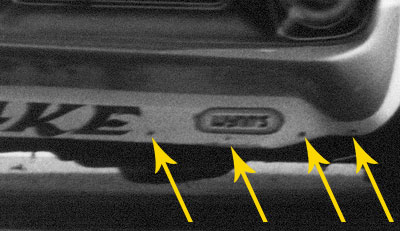 |
As to the mystery of the black car’s extended spoiler, Ricky Farrow dug out the magnifying glass and observed: “It appears to me that it was an aluminum piece attached to the front spoiler. If you look closely at the front spoiler in the ‘73 Indy photograph, you can at least see rivet holes.
"The front spoiler extension reappears at Ontario [1973] when he ran that then-unbelievable 6.16, which was I think a tenth quicker than the rest of the field and remained on the car 'til its first retirement at the Irwindale Grand Premiere. I remember it being on the car when he bought it out of retirement to win the Gatornationals in ‘74, then it went away for good by the spring. I was fortunate to keep a couple drag racing magazines from that period.”
FLASH! THIS JUST IN: Just as I was ready to publish this column, I received a FedEx package from Allum that includes original Chrysler-Plymouth PR photos of the Rapid Transit version of the 'Cuda and extra and interesting info that I'll share Friday. Stay tuned!



















































